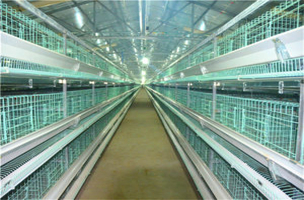Spring egg laying management method
- font size
- Be the first to comment!
The temperature in the spring begins to rise, the physiological function of the chicken is growing, and various germs are also easy to breed. Therefore, it is necessary to pay attention to the anti-epidemic and health care work of the chicken in the layer chicken cage .
In the spring, the outside temperature gradually rises, which is suitable for the chickens to lay eggs. When the temperature of the house rises to 15 °C, it is at the peak of egg production (23~40 weeks old), medium term (41~55 weeks old) and late (56~ Chickens at 72 weeks of age have an upward trend in laying eggs. However, as the temperature increases, the feed intake of the flock will decrease. Therefore, farmers must do a good job in the daily management of the chickens:It is necessary to ensure that the chickens are provided with high-quality, balanced and adequate feed, especially for the chickens at the peak of egg production; to ensure the absolute safety of the water source and to ensure adequate drinking water supply, so as not to affect the performance of the laying of the chickens.
The temperature difference between day and night in spring is large, which causes the external temperature to change drastically. It is easy to cause unstable egg production in the flock. The egg production rate fluctuates within 2%~3% within 1 week. Management should be based on ventilation, supplemented by ventilation, timely increase the control temperature of the fan, reduce the operating frequency of the fan, ensure that the temperature is stable and appropriate, and reduce the stress caused by temperature fluctuations. When encountering wind or dusty weather, the distance and quantity of ventilation windows should be properly controlled to reduce the air intake, reduce the wind speed, prevent thief winds from attacking and reduce dust.

In the spring, all things are revived, and the speed of reproduction of bacteria and viruses is accelerated. Especially in the field where chickens have been raised for many years, it is easy to cause infectious bronchitis, Newcastle disease, avian flu and other diseases, which have irreversible effects on laying eggs. Therefore, in the spring, we should pay attention to the growth and decline of infectious virus bronchitis, chicken Newcastle disease, avian influenza and other viral diseases, and timely replenishment to maintain the stability of egg production.
Develop a detailed immunization program and complete the immunization with quality, especially the immunity of avian flu and Newcastle disease, because spring is the high season for both diseases. Some farm households have chosen to reduce ventilation in order to avoid the spring instability factors that cause disease in the flock. It is precisely because of this that the harmful gases in the chicken house and the growth of pathogenic microorganisms have caused a greater harm to the chickens. Spring breeder breeders should develop the habit of opening windows in the daytime, diligently closing the window at night, and observing the temperature regularly. When the morning sun comes out and the temperature rises gradually, the ventilation window or shed cloth can be properly opened to ensure that there is enough fresh air in the house; when the temperature drops in the evening, the ventilation facilities such as small windows are closed. Guarantee the temperature inside the house at night.
When we raising chciken in poultry farming equipment It is necessary to do a good job of disinfecting the environment inside and outside the house and the drinking water pipeline, and reduce the content of harmful substances as much as possible. In order to ensure that the laying performance of the flock is better in the spring, attention should be paid to the improvement of hardware facilities to reduce the impact of stress factors on the flock.


